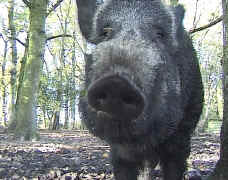What is a Woodland?
(2)
previous
 |
 |
 |
Life in a woodland tends to be secretive. A quick casual look might lead an observer to conclude that there were no animals present. However, closer, quiet (!) observation will reveal a world seething with activity and life. All of the different types of plants, fungi and lichens in a woodland offer a wide range of food choices, not to mention hiding places, for an even greater variety of animals. These might include invertebrates such as aphids and leaf miners feeding on leaves in the tree canopy. Butterfly caterpillars munch their way through grasses and herbs on the woodland floor, while deer browse on tender shoots and young saplings. The rich larder of herbivores (plant-eaters) in turn provides food for many different carnivorous animals. Ground beetles hunt the woodland floor in search of smaller prey. Song birds dart through the tree canopy seeking out insects and small invertebrates. Sparrowhawks in turn, hunt the small birds, while signs of fox and badger are visible to the discerning eye.
Nature is the ultimate recycler and nowhere is this more apparent than in woodlands. Dead rotting wood provides a rich hunting ground for the weird and wonderful of the invertebrate world. Amazingly, over 1,700 different kinds of invertebrates can be found living in rotting wood habitats in Britain. The decaying leaf litter beneath the trees will also be full of small invertebrates, while the soil beneath it is similarly alive with tiny creatures. Stand in a wood and it is probable that there is more life in the soil beneath your feet than there is above it! In addition to millions of invertebrates and bacteria, the soil will be riddled with thousands of miles of fungal hyphae, which many plants and particularly the trees, depend upon for their very survival. The mushrooms or toadstools that we commonly see are merely the reproductive structures.
The specific plants and animals to be found in a woodland depend very much on the type of woodland involved. There are a great many different types of woodland. They are generally identified by the type and/or mix of dominant trees making up the main canopy of the woodland. Continue to Types of Woodland |

